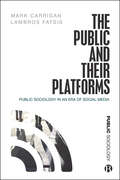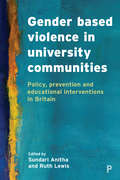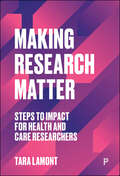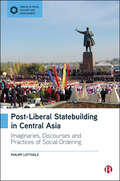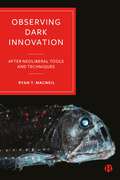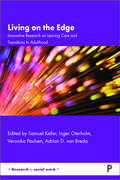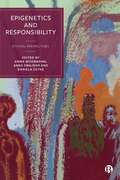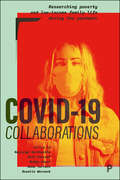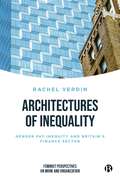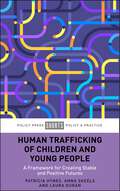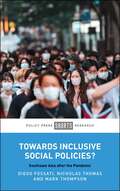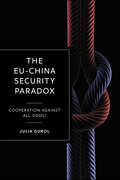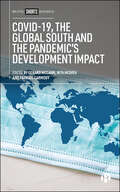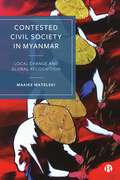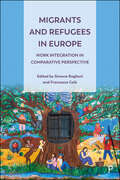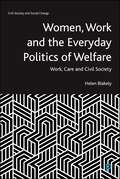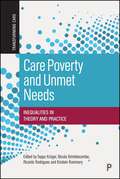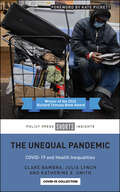- Table View
- List View
The Environment in Global Sustainability Governance: Perceptions, Actors, Innovations
by Lena PartzschAvailable Open Access digitally under CC-BY-NC-ND licence. With Agenda 2030, the UN adopted wide-ranging Sustainable Development Goals (SDGs) that integrate development and environmental agendas. This book focuses on the political tensions between the environmental objectives and socio-economic aspects of sustainable development. The collection provides an introduction to interlinkages, synergies and trade-offs between the ‘green’ and other goals, such as gender equality and economic growth. It also considers related goals on cities and partnerships as crucial for implementing environmentally sound sustainability. Identifying governance failures and responsibilities, it advocates for a shift towards cooperative economics and politics for the common good.
Revisiting Reflexivity: Liveable Worlds in Research and Beyond (Dis-positions: Troubling Methods and Theory in STS)
by Sarah R. Davies, Andrea Schikowitz, Fredy Mora-Gámez, Elaine Goldberg, Esther Dessewffy, Bao-Chau Pham, Ariadne Avkıran and Kathleen GregoryAvailable open access digitally under CC-BY-NC-ND licence. How can we nurture more liveable worlds in today’s neoliberal academia and beyond? This collection revisits the notion of reflexivity from a science and technology studies (STS) perspective, asking how researchers are affected by, and affect, the worlds they engage with. Using experimental formats that challenge academic convention, the volume acknowledges the ‘dark sides’ of reflexivity, while insisting that it is nonetheless worthwhile striving for it. This volume is essential for anyone interested in creative, playful and always incomplete attempts to refresh reflexivity in research, and in developing more liveable worlds for ourselves and those our research engages with.
The Public and Their Platforms: Public Sociology in an Era of Social Media (Public Sociology)
by Mark Carrigan Lambros FatsisAvailable Open Access digitally under CC-BY-NC-ND licence. As social media is increasingly becoming a standard feature of sociological practice, this timely book rethinks the role of these mediums in public sociology and what they can contribute to the discipline in the post-COVID world. It reconsiders the history and current conceptualizations of what sociology is, and analyzes what kinds of social life emerge in and through the interactions between ‘intellectuals’, ‘publics’ and ‘platforms’ of communication. Cutting across multiple disciplines, this pioneering work envisions a new kind of public sociology that brings together the digital and the physical to create public spaces where critical scholarship and active civic engagement can meet in a mutually reinforcing way.
Capitalism Reloaded: The Rise of the Authoritarian-Financial Complex
by Peter BloomAvailable Open Access digitally under CC-BY-NC-ND license. In Capitalism Reloaded, Peter Bloom charts a pivotal shift from the well-known military-industrial complex to a new ‘Authoritarian-Financial Complex’. Unlike its predecessor, which centred on armaments and defence, this emerging power structure fuses financial interests with advanced surveillance and digital control, turning social repression into a lucrative industry. Bloom introduces a ground breaking theory of ‘complex power', where control itself becomes a central driver of capitalism, shaping economies and societies. Bloom explores how this insatiable demand for security and profit extends beyond traditional authoritarian regimes, permeating everyday life and eroding democratic freedoms. This book challenges readers to confront the deep entanglements of modern capitalism before they solidify into a techno-authoritarian order.
Gender Based Violence in University Communities: Policy, Prevention and Educational Initiatives
by Sundari Anitha and Ruth LewisUntil recently, higher education in the UK has largely failed to recognise gender-based violence (GBV) on campus, but following the UK government task force set up in 2015, universities are becoming more aware of the issue. And recent cases in the media about the sexualised abuse of power in institutions such as universities, Parliament and Hollywood highlight the prevalence and damaging impact of GBV. In this book, academics and practitioners provide the first in-depth overview of research and practice in GBV in universities. They set out the international context of ideologies, politics and institutional structures that underlie responses to GBV in elsewhere in Europe, in the US, and in Australia, and consider the implications of implementing related policy and practice. Presenting examples of innovative British approaches to engagement with the issue, the book also considers UK, EU and UN legislation to give an international perspective, making it of direct use to discussions of ‘what works’ in preventing GBV.
Making Research Matter: Steps to Impact for Health and Care Researchers
by Tara LamontEPDF and EPUB available Open Access under CC-BY-NC-ND licence. Written by a leading expert in the field, this practical and accessible book is an essential guide to knowledge exchange, impact and research dissemination in health and social care. Providing the why, what, who, how and when of research impact, the book helps researchers turn raw findings into useful, high-impact evidence for policymakers, practitioners and the public. It includes insightful interviews from leading journalists, science communicators, researchers and influencers in health and social care, as well as practical exercises, insider tips and case studies. The book will help researchers at all stages of their career to maximise the impact of their work.
Post-Liberal Statebuilding in Central Asia: Imaginaries, Discourses and Practices of Social Ordering (Spaces of Peace, Security and Development)
by Philipp LottholzEPDF and EPUB available Open Access under CC-BY-NC-ND licence. Drawing on decolonial perspectives on peace, statehood and development, this illuminating book examines post-liberal statebuilding in Central Asia. It argues that, despite its emancipatory appearance, post-liberal statebuilding is best understood as a set of social ordering mechanisms that lead to new forms of exclusion, marginalization and violence. Using ethnographic fieldwork in Southern Kyrgyzstan, the volume offers a detailed examination of community security and peacebuilding discourses and practices. Through its analysis, the book highlights the problem with assumptions about liberal democracy, modern statehood and capitalist development as the standard template for post-conflict countries, which is widespread and rarely reflected upon.
Observing Dark Innovation: After Neoliberal Tools and Techniques
by Ryan T. MacNeilAvailable open access digitally under CC-BY-NC-ND licence. Why does scholarship on innovation fixate on certain classes of technology? Could our research tools and techniques be concealing as much as they reveal? Ryan T. MacNeil shows how the common instrumentalities of innovation research carry neoliberal market biases. He calls for critical scholars to examine how we observe and understand innovation, offering ways forward to deconstruct and reform disciplinary conventions. This book makes a valuable contribution to critical management and science and technology studies by shedding light on the ‘dark matter’ of innovation. This will be an important resource for scholars and practitioners interested in disruptive ideas about innovation.
Living on the Edge: Innovative Research on Leaving Care and Transitions to Adulthood (Research in Social Work)
by Samuel Keller, Inger Oterholm, Veronika Paulsen and Adrian D. van BredaEPDF and EPUB available Open Access under CC-BY licence. Young people transitioning out of care towards independence, work and adulthood are on the edge of these phases of life. Considering previously neglected groups of care leavers such as unaccompanied migrants, street youth, those leaving residential care, young parents and those with a disability, this book presents cutting-edge research from emerging global scholars. The collection addresses the precarity experienced by many care leavers, who often lack the social capital and resources to transition into stable education, employment and family life. Including the voices of care leavers throughout, it makes research relevant to practitioners and policymakers aiming to enable, rather than label, vulnerable groups.
Epigenetics and Responsibility: Ethical Perspectives
by Emma Moormann, Anna Smajdor and Daniela CutasEPUB and EPDF available Open Access under CC-BY-NC-ND licence. We tend to hold people responsible for their choices, but not for what they can’t control: their nature, genes or biological makeup. This thought-provoking collection redefines the boundaries of moral responsibility. It shows how epigenetics reveals connections between our genetic make-up and our environment. The essays challenge established notions of human nature and the nature/nurture divide and suggest a shift in focus from individual to collective responsibility. Uncovering the links between our genetic makeup, environment and experiences, this is an important contribution to ongoing debates on ethics, genetics and responsibility.
COVID-19 Collaborations: Researching Poverty and Low-Income Family Life during the Pandemic
by Kayleigh Garthwaite, Ruth Patrick, Maddy Power, Anna Tarrant, and Rosalie WarnockEpdf and ePUB available Open Access under CC BY NC ND licence. The COVID-19 pandemic affected everyone – but, for some, existing social inequalities were exacerbated, and this created a vital need for research. Researchers found themselves operating in a new and difficult context; they needed to act quickly and think collectively to embark on new research despite the constraints of the pandemic. This book presents the collaborative process of 14 research projects working together during COVID-19. It documents their findings and explains how researchers in the voluntary sector and academia responded methodologically, practically, and ethically to researching poverty and everyday life for families on low incomes during the pandemic. This book synthesises the challenges of researching during COVID-19 to improve future policy and practice. Also see 'A Year Like No Other: Family Life on a Low Income in COVID-19' to find out more about the lived experiences of low-income families during the pandemic.
Ineffective Policies: Causes and Consequences of Bad Policy Choices
by Ian Roberge, Heather McKeen-Edwards, and Malcolm Campbell-VerduynAvailable open access digitally under CC-BY-NC-ND licence. Bad policies have repercussions that can be felt for decades. But what makes a bad policy? And how can it be reversed or improved? Bringing together scholars from Europe and North America, this book goes beyond traditional policy theory to study bad and ineffective policies across three fields: • the environment; • the financial services sector; and • emerging technologies. Using cutting-edge research and analysis, the editors and authors state the case for studying ineffective policies, demonstrate their harmful effects across policy fields and provide policy makers with the tools to reflect, identify, and act upon them.
Feminist Conversations on Peace
by Sarah Smith and Keina YoshidaEPUB and EPDF available Open Access under CC-BY-NC-ND licence. What is feminist peace? How can we advocate for peace from patriarchy? What do women, globally, advocate for when they use the term 'peace'? This edited collection brings together conversations across borders and boundaries to explore plural, intersectional and interdisciplinary concepts of feminist peace. The book includes contributions from a geographically diverse range of scholars, judges, practitioners and activists, and the chapters cut across themes of movement building and resistance and explore the limits of institutionalized peacebuilding. The chapters deal with a range of issues, such as environmental degradation, militarization, online violence and arms spending. Offering a resource to advance theoretical development and to advocate for policy change, this book transcends traditional approaches to the study of peace and security and embraces diverse voices and perspectives which are absent in both academic and policy spaces.
White Working-Class Voices: Multiculturalism, Community-Building and Change
by Harris BeiderEPUB and EPDF available Open Access under CC-BY-NC-ND licence. Popular views of white working-class communities are common but knowledge of their views on multiculturalism and change less so. This important book provides the first substantial analysis of white working-class perspectives on themes of multiculturalism and change in the UK, creating an opportunity for these 'silent voices' to be heard. Based on over 200 interviews in multiple sites the results are startling - challenging politicians, policy makers and researchers. Improving our understanding of how this group went from 'hero to zero', became framed as racist, resistant to change and disconnected from politics, the book suggests a new and progressive agenda for white working class communities to become a fully inclusive part of a modern and diverse country in the 21st century. The book will be valuable to academics and students as well as policy-makers and practitioners in national government and organisations.
Architectures of Inequality: Gender Pay Inequity and Britain’s Finance Sector (Feminist Perspectives on Work and Organization)
by Rachel VerdinAvailable open access digitally under CC-BY-NC-ND licence. The gender pay gap is economically irrational and yet stubbornly persistent. Focusing on the UK finance industry which is known for its gender pay disparity, this book explores the initiatives to fix gendered inequities in the workplace. Rachel Verdin crafts a unique framework, weaving extensive organizational data with women's lived experiences. Interviews uncover gaps in pay transparency, obstacles hindering workplace policies and the factors that are stalling progress for the future. This is an invaluable resource that offers key insights into gender equality and EDI measures shaped by legal regulations as well as corporate-driven initiatives.
Human Trafficking of Children and Young People: A Framework for Creating Stable and Positive Futures
by Patricia Hynes Anna Skeels Laura DuránHuman trafficking of children and young people is a major concern yet there is limited research on the lived experiences of those affected and even less on their post-trafficking aspirations, strengths and capabilities. This book argues that human trafficking and/or exploitation should be seen as child abuse rather than viewed through immigration or criminal justice lenses. It draws on new research from outcomes of two participatory studies with young people affected by human trafficking. The first study focuses on the development of a Creating Stable Futures Positive Outcomes Framework (CSF-POF), centred around children’s rights and based on the views of young people themselves. The second details how this framework was implemented for the first time with young people through an outcomes evaluation of the Independent Child Trafficking Guardianship (ICTG) service in England and Wales. An invaluable text, this book guides policy makers, practitioners, local authority professionals and voluntary sector organisations working to protect children and young people from human trafficking and helping them to move forwards positively following abuse.
Towards Inclusive Social Policies?: Southeast Asia after the Pandemic
by Nicholas Thomas Diego Fossati Mark ThompsonAvailable open access under CC-BY-NC-ND licence. The COVID-19 pandemic disrupted economies and upended lives – but did it also open the door to more inclusive policies? Focusing on both attitudinal and institutional repercussions of the pandemic, and transcending Western-centric narratives and case studies, this book asks the question: has the COVID-19 pandemic facilitated the adoption of more generous and inclusive social policies in Southeast Asia? Combining original survey data with qualitative policy analysis in Indonesia, Malaysia, the Philippines, Singapore and Thailand, this concise yet rigorous volume challenges long-held beliefs and provides a comparative framework for understanding welfare change in politically and economically varied contexts. Valuable reading for anyone seeking to understand how crises can reshape public expectations and state responses.
The EU-China Security Paradox: Cooperation Against All Odds?
by Julia GurolEPUB and EPDF versions available Open Access under CC-BY-NC-ND license. In this enlightening analysis, Julia Gurol unpicks the complex security relations between the European Union (EU) and China. She investigates the principles, rationales and shifting dynamics of collaboration on a range of security issues, and their consequences for China, the EU and other regions. She pays particular attention to EU–China relations in the realm of anti-terrorism, anti-piracy and energy security, and disentangles their cooperation efforts in the context of increasing political and economic tensions. Systematic and accessible, this is an essential guide to the past, present and future of one of the world’s most important, yet most complicated, security relationships.
COVID-19, the Global South and the Pandemic’s Development Impact
by Gerard McCann, Nita Mishra and Pádraig CarmodyEPDF and EPUB available Open Access under CC-BY-NC-ND licence. Though a globally shared experience, the COVID-19 pandemic has affected societies across the world in radically different ways. This book examines the unique implications of the pandemic in the Global South. With international contributors from a variety of disciplines including health, economics and geography, the book investigates the pandemic’s effects on development, medicine, gender (in)equality and human rights, among other issues. Its analysis illuminates further subsequent crises of interconnection, a pervasive health provision crisis and a resulting rise in socioeconomic inequality. The book’s assessment offers an urgent discourse on the ways in which the impact of COVID-19 can be mitigated in some of the most challenging socioeconomic contexts in the world.
Contested Civil Society in Myanmar: Local Change and Global Recognition
by Maaike MatelskiAvailable open access digitally under CC-BY-NC-ND licence. This book centres on various contestations in Myanmar society and illustrates the ways in which these are reflected in civil society. The book offers a concise overview of recent political developments in the country, from the short-lived attempts at democratization to the 2021 military coup, and analyses the involvement of various civil society actors, as well as their international supporters. It incorporates multiple identities and fault lines in Myanmar society and explains how these influence diverse perceptions, framing and agenda setting as political developments unfold. The book provides an up-to-date overview of the main identities and contestations within Myanmar’s civil society and, by extension, within Myanmar society as a whole. It also gives recommendations to donors, policy makers and researchers wishing to better understand and support local civil society actors operating in repressive environments.
Migrants and Refugees in Europe: Work Integration in Comparative Perspective
by Simone Baglioni and Francesca CalòEPDF and EPUB available Open Access under CC-BY-NC-ND licence. The motivations of migrants for travelling to Europe vary, and the quality of the processes involved in their settlement and contribution to social and economic development are inextricably linked to their prospects of finding and sustaining good-quality work. This book explores the labour market integration of migrants, refugees and asylum seekers across seven European countries: the Czech Republic, Denmark, Finland, Greece, Italy, Switzerland and the UK. Using empirical data from the Horizon2020 SIRIUS Project, it investigates how legal, political, social and personal circumstances combine to determine the work trajectory for migrants who choose Europe as their home.
A Realist Philosophy of Economics
by Karl MittermaierEPUB and EPDF available Open Access under CC-BY-NC-ND licence. Economic theory relies heavily on the idea of rational action, but how are we to understand the empirical content of rational choice when we can only observe the outcome, not what goes into making the choice? With contributions from Alan Kirman and Rod O'Donnell, Karl Mittermaier's posthumously published work establishes a new conceptual framework that will enable economic theorists to forge new paths of empirical analysis. Introducing readers to the work of a profound thinker who was not recognized in his lifetime, this book, featuring previously unpublished material, is poised to become a seminal text in the philosophy of social sciences.
Women, Work and the Everyday Politics of Welfare: Work, Care and Civil Society (Civil Society and Social Change)
by Helen BlakelyThe restructuring of the welfare state in the UK has marked a significant change in the way contemporary society is ordered and understood. This research monograph explores the implications of this restructuring for women and their attachments to unpaid care, paid work and activism over time. Drawing on longitudinal research involving ethnographic and narrative inquiry in the south Wales Valleys, the contribution attends to the everyday politics of welfare through its rhetorical imaginings, the practices of street level workers and across the interactions of women themselves. Immersive and critical, the account provides valuable insights for our understanding of welfare restructuring and the future development of the welfare state.
Care Poverty and Unmet Needs: Inequalities in Theory and Practice (Transforming Care)
by Teppo Kröger, Nicola Brimblecombe, Ricardo Rodrigues and Kirstein RummeryAvailable open access digitally under CC-BY-NC-ND licence. As populations age around the world, there is an urgent need to address the inadequate and unequal provision of care and support to older and disabled people. This book represents the first collective effort to use the concept of care poverty to analyse unmet needs and inequalities in care at an international level and from a social policy perspective. It presents pioneering empirical studies and novel theoretical and methodological approaches to unmet needs and care poverty. This volume points the way forward for international care research and, in particular, for the growing field of research on inadequate care and support.
The Unequal Pandemic: COVID-19 and Health Inequalities
by Clare Bambra Julia Lynch Katherine E. SmithRated as a top 10 book about the COVID-19 pandemic by New Statesman: https://www.newstatesman.com/culture/2021/07/best-books-about-covid-19-pandemic EPDF and EPUB available Open Access under CC-BY-NC- ND It has been claimed that we are ‘all in it together’ and that the COVID-19 virus ‘does not discriminate’. This accessible, yet authoritative book dispels this myth of COVID-19 as an ‘equal opportunity’ disease, by showing how the pandemic is a syndemic of disease and inequality. Drawing on international data and accounts, it argues that the pandemic is unequal in three ways: it has killed unequally, been experienced unequally and will impoverish unequally. These inequalities are a political choice: with governments effectively choosing who lives and who dies, we need to learn from COVID-19 quickly to prevent growing inequality and to reduce health inequalities in the future. COVID-19 is an unequal pandemic.


